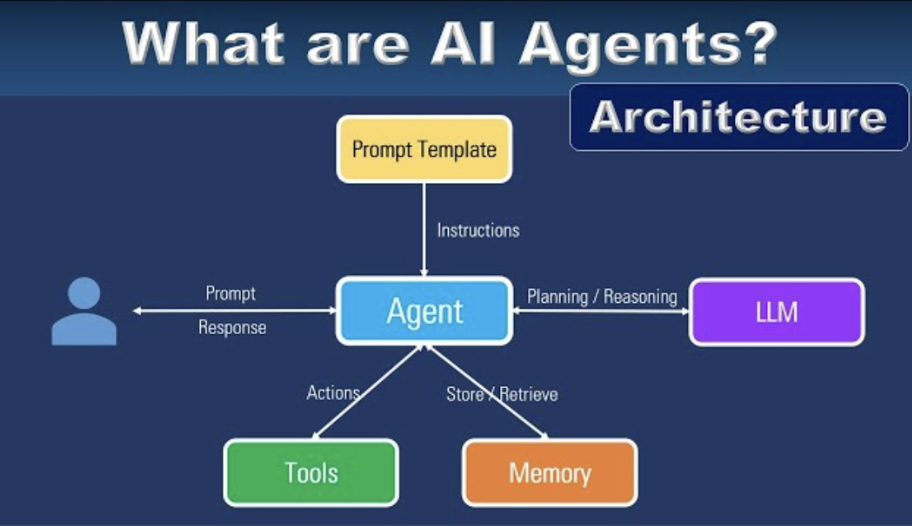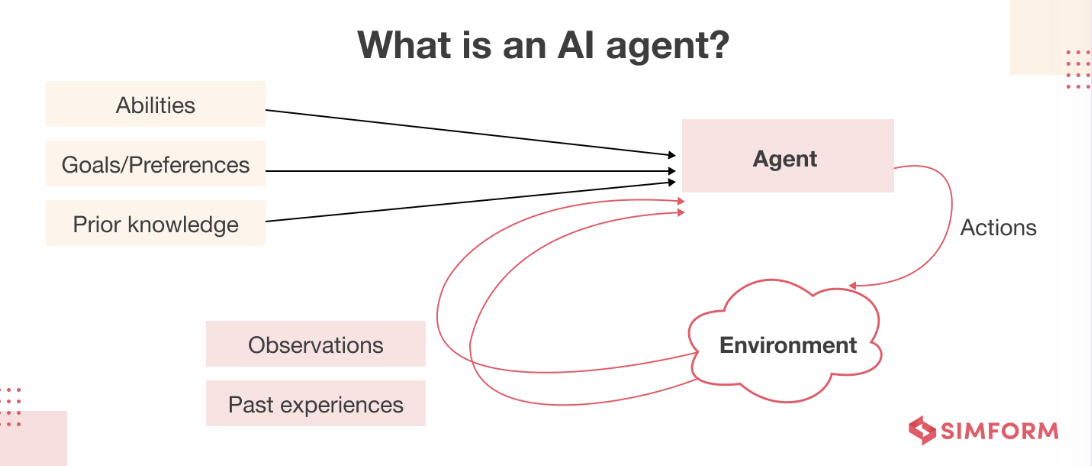
Source: Salesforce
Introduction
Imagine you own a large e-commerce platform that receives thousands of customer support queries every minute. These queries range from simple requests like checking order status to complex issues such as processing returns or resolving billing problems. On one hand, it is tedious for humans to efficiently handle this volume, leading to long wait times and frustrated customers. On the other, traditional automated systems lack the ability to take meaningful actions or adapt to complex scenarios. Because they operate based on predefined rules and responses, they are limited by their configuration and don’t possess the agency to make decisions beyond their programming. This is where AI agents come into play.
What are AI Agents?
An AI agent is an autonomous entity that can perceive its environment, make decisions, and take actions to achieve specific goals. Unlike traditional automated systems, AI agents can handle complex, dynamic tasks by learning from data and interactions. With these capabilities, AI agents are driving innovations across various industries. This article will cover the motivation for AI agents, their components, applications, and impact on society.
Comparing an Agentic Chatbot with a Non-Agentic Chatbot
Let’s compare a Non-Agentic Customer Service Chatbot with an Agentic Customer Service Chatbot to further illustrate what distinguishes an AI Agent.
Non-Agentic Chatbot
- Capabilities: The non-agentic chatbot can handle predefined queries like checking order status, providing store hours, and answering FAQs. It uses a rule-based system, matching user input with a set of predefined responses.
- Interaction: When a customer asks, “What are the store hours?”, it answers “M-W 9-5pm,” because this question/answer pair has been defined in its rule-based system. However, if the customer follows up with, “Are you open on holidays?”, the chatbot may not have a predefined response for this query. As a result, it might either give a generic error message or repeat its initial response, showing its inability to handle variations or follow-up questions that fall outside its programmed knowledge base.
- Limitations: This non-agentic chatbot struggles with complex or unexpected queries, especially those that require taking specific actions. For instance, if a customer asks, “Can I change my delivery address after ordering?”, the chatbot is unable to handle this request. Since it relies solely on predefined question-answer pairs and rule-based responses, it cannot access the order management system or execute any changes. Instead, it may respond with a generic message like “I don’t understand your question” or refer the customer to a human agent, highlighting its inability to perform dynamic, action-oriented tasks.
Agentic Chatbot
- Capabilities: The agentic chatbot is designed with AI capabilities, and can handle complex tasks, learn from interactions, and make decisions to resolve customer issues beyond basic queries.
- Interaction: When a customer asks, “Can I change my delivery address after ordering?”, the agentic chatbot not only understands the request but also takes action on the customer’s behalf. It accesses the order management system to check if the address can be updated and, if allowed, it directly makes the change for the customer. If the update isn’t possible, the chatbot offers alternative solutions, such as providing contact details for customer support or suggesting other options. This ability to take meaningful actions, rather than merely providing information, sets the agentic chatbot apart and enhances the overall customer service experience.
- Advantages: This agentic chatbot adapts to new queries over time and takes actions based on user interactions. It offers a more effective customer service experience by not only understanding a broader range of inquiries but also acting on them, such as updating orders or processing requests directly. This eliminates the need for predefined responses for each scenario, allowing the chatbot to handle complex tasks autonomously and efficiently.
The key difference between a non-agentic chatbot and an agentic chatbot lies in their agency, or their ability to act. While a non-agentic chatbot can only provide predefined responses to queries, an agentic chatbot can take meaningful actions on behalf of the user, such as updating order details or resolving issues autonomously. This action-oriented capability enables the agentic chatbot to handle a wider range of tasks and offer a more dynamic and personalized customer service experience.
Components of AI Agents
AI agents consist of several core components that enable them to perform tasks autonomously and effectively:

Source: YouTube
- Prompt: The prompt is the initial input or set of instructions provided to the AI agent. It defines the context and guides the agent on what task to perform. A well-constructed prompt helps the agent understand the user’s intent and generates more accurate and relevant responses. Prompt templates act as guidelines for crafting effective responses.
- Large Language Model (LLM): The core component of most AI agents is an LLM, such as OpenAI’s GPT models. The LLM processes the prompt, generates human-like text, and performs complex language-based tasks. It leverages vast amounts of training data to understand and generate responses across a wide range of topics.
- Tools: Tools are external systems or APIs that the AI agent can interact with to perform specific actions beyond text generation. For example, an AI agent might use a database to retrieve information, a calendar API to schedule appointments, or an e-commerce platform to update order details on someone’s behalf. These tools enable the agent to take actions in real-world applications.
- Memory: Memory allows the AI agent to retain information across interactions, making it contextually aware and capable of maintaining coherent, long-term conversations. With memory, the agent can recall previous user inputs, preferences, and ongoing tasks, enhancing personalization and improving the user experience over time.
AI agents operate within an environment, which could be physical (like a warehouse for robots) or virtual (like a network for virtual assistant bots). Their interaction with this environment involves a continuous feedback loop where the agent perceives, decides, and acts, refining its behaviors based on outcomes. Together, these components empower AI agents to understand, reason, and act effectively.

Source: Simform
Relationship between AI Agents and RAG
AI agents leverage Retrieval-Augmented Generation (RAG) to enhance their capabilities by combining retrieval-based systems with generative models. RAG allows LLMs to pull relevant information from external sources, such as documents or databases. This improves the accuracy and relevance of their responses. Essentially, RAG integrates an LLM with access to additional data repositories, enabling more informed outputs. However, simply having access to external documents or databases through RAG does not necessarily make an AI system an agent. True AI agents are characterized by their ability to autonomously take actions and make decisions based on their environment and objectives, whereas RAG primarily enhances information retrieval and response generation.
Applications of AI Agents
- Healthcare: They assist in diagnostics, treatment recommendations, and patient monitoring, enhancing precision and efficiency.
- Finance: AI agents conduct algorithmic trading, detect fraud, and improve customer support through intelligent chatbots.
- Autonomous Vehicles: Self-driving cars from companies like Tesla and Waymo use AI agents to process real-time sensor data and make driving decisions. These agents continuously learn from vast amounts of driving data, enhancing their ability to handle complex road scenarios.
- Customer Service: AI-powered chatbots manage customer inquiries, offering instant responses and reducing the workload on human agents. A well-known example is Amazon’s AI assistant, Rufus, which handles a significant portion of customer service inquiries. Rufus efficiently resolves common issues and allows human representatives to focus on more complex problems.
Ethical Considerations
As AI agents become more prevalent, several ethical considerations arise:
Privacy: Handling sensitive data requires robust measures to protect user privacy and data security. The research paper “Membership Inference Attacks Against Machine Learning Models” by Shokri et al. demonstrated that machine learning models could unintentionally leak information about the individual data points they were trained on.
Bias: AI agents can inherit biases from the data they are trained on, leading to unfair or discriminatory outcomes. A notable example is the case of COMPAS, an algorithm used in the U.S. judicial system to assess recidivism. Studies found that COMPAS exhibited racial bias, disproportionately misclassifying Black defendants as high-risk compared to white defendants.
Transparency: The decision-making processes of AI agents should be interpretable to ensure trust and accountability.
Future of AI Agents
AI agents have the potential to significantly transform industries and improve the quality of life across various domains. Their ability to autonomously perform complex tasks and adapt to new situations positions them as a powerful tool for enhancing productivity and efficiency. In customer service, agentic chatbots can provide personalized support, reduce response times, and handle a vast array of inquiries. Ultimately, this allows people to focus on more complex issues.
However, these advancements also come with challenges. One of the most significant concerns is job displacement, as AI agents can automate tasks traditionally performed by humans. This raises ethical dilemmas about the future of work. Furthermore, it highlights the need for reskilling the workforce to adapt to the changing job landscape. AI agents must be designed with transparency and fairness to avoid biases and ensure they make equitable decisions.
The future of AI agents holds the promise of developing more generalized agents capable of performing a broader range of tasks with higher autonomy and intelligence. These agents could integrate seamlessly into everyday life, assisting with personal, professional, and societal needs.
Videos for Further Exploration
- In the video titled “What are AI Agents?“, Maya Murad from IBM Technology, gives a great overview of AI Agents and their evolution (Runtime: 12 min)
- In “AI Agents Architecture” video by Architecture Bytes, the speaker provides an introduction to different types of AI Agents as well as their architectures (Runtime: 8 min)
- In this video, “AI Agents and AI Assistants: A Contrast in Function“, Amanda Downie and Martin Keen from IBM Technology provide a great short comparison between AI agents and assistants like ChatGPT (Runtime: 7 mins)
Related Articles



